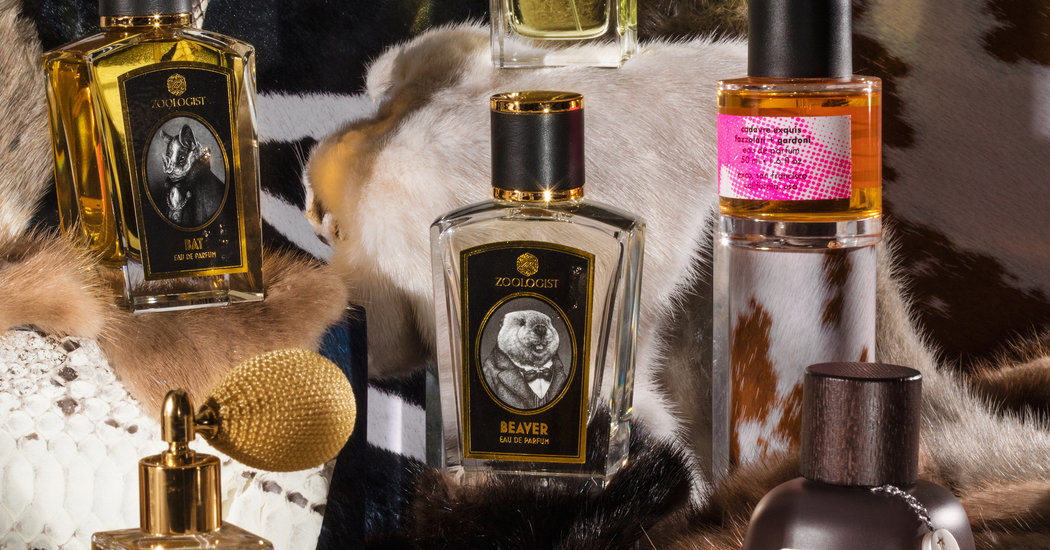In 2012, Victor Wong, a video game designer for a toy company in Toronto, had a tiny midlife crisis in his hotel room while on vacation. He felt burned out on work but was strangely revived by sniffing the hotel toiletries, which came from a niche fragrance line he can no longer recall.
What he does remember is that he swooned over the scents, which were spicy, musky and intense. He knew then and there that he wanted to make perfume.
Returning home, Mr. Wong began haunting the message boards of the cult perfume sites BaseNotes and Fragrantica, feverishly researching the formulas behind his favorite scents. The same notes kept popping up: castoreum, civet, musk, ambergris. He realized that he was drawn, in an instinctual way, to animal-derived scents — or rather (because most perfumery materials that come from animals are now banned or heavily regulated) to their lab-created chemical equivalents.
When Mr. Wong worked up the courage to put out an open call online for a perfumer to help him create his fragrance, he already had a specific, and beastly, concept in his head. He would call his line Zoologist, and he would release a series of scents named for the wild creatures that inspired them.
The British perfumer Chris Bartlett was the first to respond, with a bold idea for the maiden fragrance in the Wong menagerie. He wanted to capture the essence of a beaver. Mr. Bartlett proposed a scent that used no real animal ingredients, but smelled strongly of wet fur, dank musk, felled trees and the sour buttery odor of a beaver’s castor sac secretions.
Mr. Wong said yes immediately. When Beaver hit the market in 2014, it immediately became a polarizing sensation in the niche perfume world. CaFleureBon, which reviews cult perfumes, named it one of the best of the year, and fans flocked to its peppery, sweaty funk. But, as Mr. Wong now admits, “it was ultimately too challenging for a lot of people.”
“A lot of people thought it was interesting but said that they would never wear it,” he said. The smell of damp pelt (and the not-so-subtle bodily connotations of the name) made some customers feel uncomfortable rather than swaddled in the dense odor.
So Mr. Wong asked Mr. Bartlett to revisit his formula, and this fall they released Beaver 2016, a riff on the original idea but with more “fresh air and river top notes to make it more attractive.”
NYT Living Newsletter
Get lifestyle news from the Style, Travel and Food sections, from the latest trends to news you can use.
Thank you for subscribing.
An error has occurred. Please try again later.
You are already subscribed to this email.
Mr. Wong has released six other perfumes, including Bat, a pungent reverie on banana, cave dirt, musk and overripe figs from the perfumer Dr. Ellen Covey that won the top prize at the 2016 Art and Olfaction Awards. The venerable fragrance critic Luca Turin gave Bat a rave, writing that “the fragrance seems lit from within by the earth note all the way to drydown.”
It turns out that Mr. Wong’s animal instincts were right along: In 2016, the demand for fauna-inspired scents is cresting.
“Animalic” is a buzzword floating around the industry, now that the minimalist, clean trend has given way (at least in high-fashion niche circles) to more feral fragrance clouds. Maybe it’s the desire of millennials to reclaim their beastly odors in an age of technological detachment, but fragrance buyers are newly excited to smell as if they come from an elegant zoo.
A new line capitalizing on this trend is Eris Parfums, a collection from Barbara Herman, a writer-turned-perfumer who runs the cult-popular vintage fragrance site Yesterday’s Perfume and whose book, “Scent and Subversion: Decoding a Century of Provocative Perfume,” was published in 2013. When Ms. Herman decided to switch from writing about perfume to making it, she knew that the bestial would serve as her primary inspiration.
“I got absolutely obsessed with animalics,” she said. “I had these little bottles of old Lanvin and Piguet scents, which rely on notes like civet and castoreum, and I had such a physical reaction to them. They were rounder, deeper. They made me emotional.”
In her research, Ms. Herman found that many of her favorite vintage perfumes relied on a base accord called Animalis, developed by a French company in the 1920s. Animalis, in its original form, was an unctuous golden liquid comprised civet, castoreum, costus and musk, and smelled a bit like body odor, dirty scalp, perspiration, butter and a horse stable. Though it sounds unappealing on its own, when combined with other materials, consumers couldn’t resist it. Animalis found its way into popular scents like Robert Piguet Visa and YSL Kouros.
Though the note changed once real animal products were banned in modern perfumery, Ms. Herman still wanted to mimic its singular tang. This summer, she introduced three perfumes, including Ma Bête, which pairs boozy florals like jasmine and neroli with more brutish notes of benzoin, patchouli and a new chemical base blend that mimics the vintage Animalis.
“The word ‘beast’ kept coming up for me,” Ms. Herman said. “It’s like the tension between Beauty and the Beast. She’s afraid but drawn, identified but repelled. It is compelling now, especially with the internet, to remind ourselves that we are animals.”
A few of the latest crop, like the Papillon Artisan Perfumes Salome (a heady cumin-forward bestial) and Bruno Fazzolari and Antonio Gardoni’s experimental new scent Cadavre Exquis (which smells a bit like rigor mortis), are aggressively difficult, with the intent to curl and confuse the nose. This can draw consumers who want to confront their darker desires.
Stephen Dirkes, a self-taught perfumer who runs the fanciful Euphorium Brooklyn from his workshop in Greenpoint says that animalic scents are, in a twisted way, about confronting mortality. “There is a death drive in these smells,” he said over coffee, waving a tin of authentic ambergris from the belly of a whale under my nose. It smelled of boiled fat, mollusks and salt, and was impossible to stop sniffing.
“I like to think about how fashion is often elevated as an expression of personal style, like art you can wear, but it’s also an expression of self-loathing,” he said. “Grasse, in France, where great perfumery came from, was also a tannery town. The smell of death and the smell of flowers went hand in hand.”
One of Euphorium’s best-selling scents is Suédois, a spicy leather concoction that still contains sharp hints of tannery tang. The same earthy leather can be found in the YeYe Parfums signature scent Equus, which the perfumer Ernesto Sanchez Bujanda says was directly inspired by “the life of a horse: stables, wood, hay, sweat, skin and the beauty of the animal.”
Civets, musks and other beastly secretions become most desirable as the weather turns colder. They’re simply too intense for the summer months, and, as Ms. Herman notes, animalics are ultimately deeply comforting, cozy perfumes to wear. They are like cashmere sweaters in a bottle.
“Animalics melt with the skin,” she said. “They are a bridge between the perfume and you. When I wear them, they become a part of me. You don’t wear these kinds of fragrances, you submit to them.”
SOURCE:http://www.nytimes.com/2016/10/27/fashion/skin-deep-animal-perfumes.html



